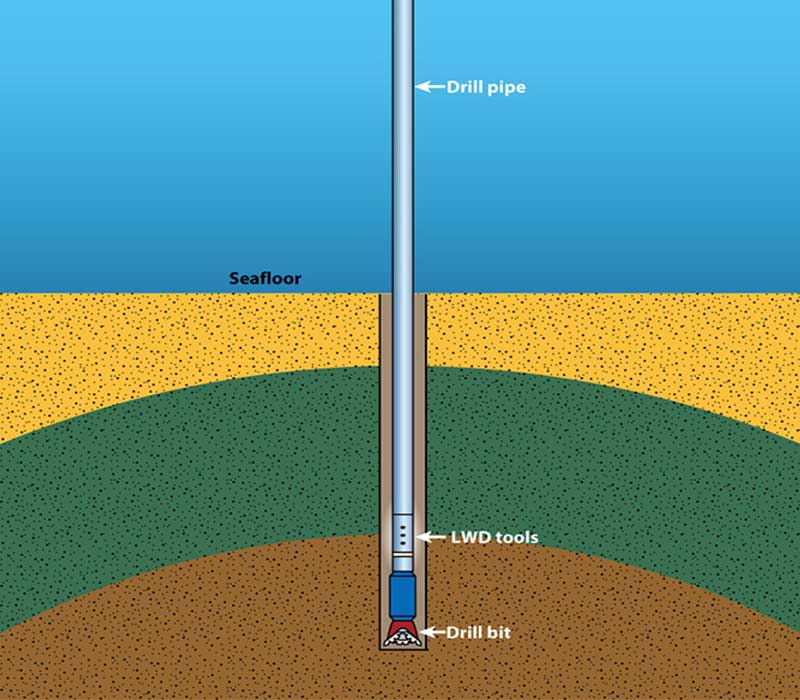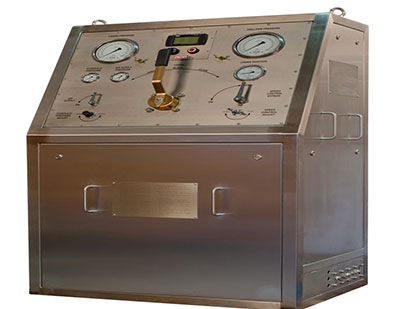Pressure and overpressure formation in Well Drilling
What is pressure?
A pressure is a force divided by the surface where this force applies.
Pressure Pascal = Force Newton / Surface m2
The official pressure unit is the Pascal
It is a very small unit: 1 Pascal = 1 Newton/m2
1 bar = 105 Pascal
1 atm = 1,013 *105 Pascal
A practical unit on the rig is the kgf/cm2
1 kgf/cm2 = 0.981 bar
In API , the unit is the pound per square inch (psi)
1 bar = 14.4988 psi
Hydrostatic Pressure: Ph
Pressure exerted by the weight of a static column of fluid. It is a function of fluid specific gravity and of vertical height of the fluid.
Ph = d * g * H
With Ph = hydrostatic pressure (Pascal)
d = Fluid specific gravity (kg/m3)
H = Vertical height of fluid (m)
Using well site units, the formula becomes:
Ph = H*d
10
With Ph= hydrostatic pressure (bar or kg/cm2)
d = Fluid specific gravity (kg/l)
H = Vertical height of fluid (m)
Note: The term 10 is approached, for precision, you should use 10.2 with pressure in bars and 9.6 for pressure in kg/cm2
In API, the formula is: Ph = 0.052 * H * d
With Ph= hydrostatic pressure (psi)
d = Fluid specific gravity (ppg)
H = Vertical height of fluid (ft)
Overburden: S
At a given depth, the overburden is the pressure (applying on fluids) or stress (applying on matrix) exerted by the weight of the overlying sediments.
S = H * ∂b
10
With S = Overburden stress (kg/cm2)
∂b = Formation average bulk density (no unit)
H = Vertical thickness of overlying sediments (m)
In API, the formula is:
S = H * ∂b * 0.433
With S = Overburden stress (psi)
∂b = Formation average bulk density (no unit)
H = Vertical thickness of overlying sediments (ft)
The bulk density of sediment is a function of the matrix density, the porosity and the density of the fluid in the pores.
∂b= (Φ * ∂f) + (1-Φ) * ∂m
With ∂b = Bulk density (no unit)
∂f = Formation fluid density (no unit)
Φ = Porosity (from 0 to 1)
∂m = Matrix density (no unit)
With depth, the sediment porosity will decrease under the effect of compaction (proportional to overburden) and of course, the bulk density will increase.
You will note that the porosity shale curve is exponential
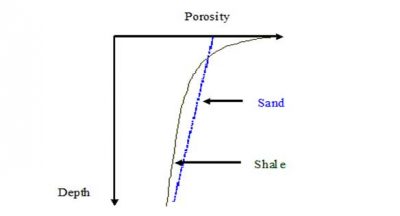
FORMATION PRESSURE: Pf
Also called Pore pressure: Pp. Is Pressure of the fluid contained in the pores of the sediment
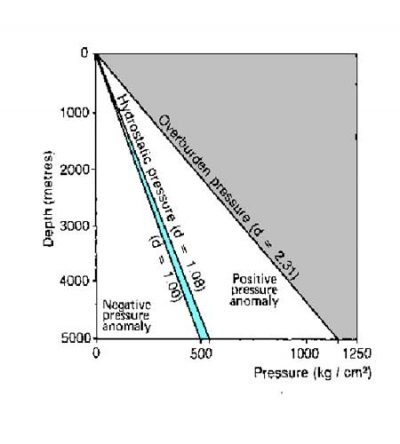
NORMAL Pf: Pf=Ph
The formation pressure (Pf) equals the hydrostatic pressure (Ph) due to the column of fluid in the sediment. It depends on the density of the water (usually from 1.00 to 1.08)
NEGATIVE Pf ANOMALY: Pf<Ph
In the following example, the outcrop is lower than the point where the well enter the formation. The water does not reach this zone.
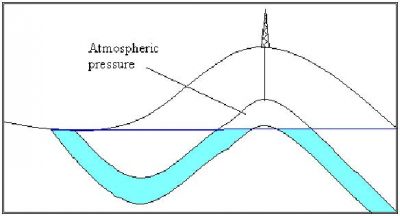
POSITIVE Pf ANOMALY: Pf>Ph
Artesian well: In this case:
Pf = H*d /10 instead of h * d / 10
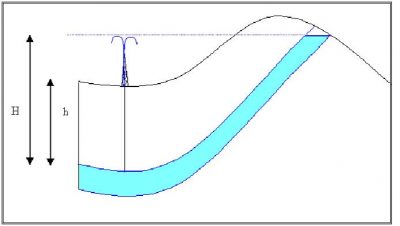
Hydrocarbon column
Due to the difference of densities between water and hydrocarbons, the pressure at the top of the reservoir is almost the same that at hydrocarbon –water contact
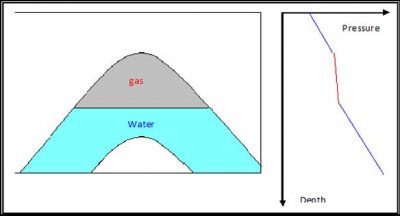
The formula for the pressure anomaly (excess of pressure respect to normal) is:
Phc = H * (dw – dhc)
10
With
Phc = Pressure anomaly at the top of the hydrocarbon column (kg/cm2)
H = Height of the hydrocarbon column (m)
dw = Water SG (kg/l)
dhc = Hydrocarbon SG (kg/l)
Note that this anomaly is proportional to the height of the hydrocarbon column and to the difference of SG between water and hydrocarbon.
Pressure & mud weight
Equilibrium & equivalent mud weight
Equivalent Mud weight is the MW corresponding to a mud column pressure, related to depth. It represents the average mud weight needed to counterbalance formation pressure Pf
From the hydrostatic pressure (Ph) formula, we can recover:
MW = P * 10
H
PRESSURE GRADIENT: G
A pressure gradient G is the unit increase in pore pressure for a vertical increase in depth unit, but to get consistency with mud weight, we will take 10m.
It is used to give a degree of consistency to pressure data: Pressure gradient and mud weight will be comparable. As the figures are similar, MW and Pressure gradient may be plotted on the same graph, allowing a comparison between MW, Formation pressure gradient, Fracture gradient (fracture pressure gradient is the pressure required to induce fractures in rock at a given depth) and Overburden gradient.
As the figures are similar, MW and Pressure gradient may be plotted on the same graph, allowing a comparison between MW, Formation pressure gradient, Fracture gradient and Overburden gradient.
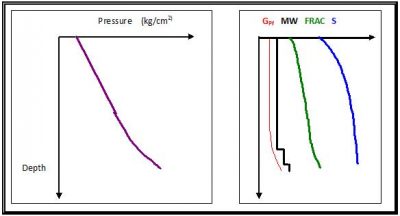
Stress Concept
Unlike liquids, solids can withstand different loads in various directions: Imagine a cube of porous rock somewhere in the deep. We can divide the stresses in 3 resulting forces according to the 3 directions of space: S1 can be considered as the Overburden , S2 and S3 the tectonic forces (open hole ovalization can give an idea of the difference between S2 and S3).
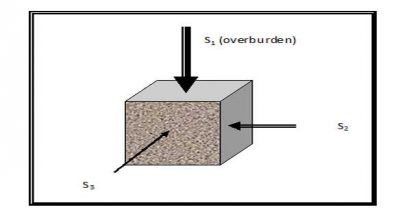
In a porous rock, the fluid may support part of the stress (due to undercompaction) and the total stress S will have 2 components:
S = Pp + ☌ (Terzaghi equation)
With S = Total stress (kgf/cm2)
Pp = Pore pressure ( or formation pressure) (kgf/cm2)
☌ = Effective stress (on the grains of the rock) (kgf/cm2)
Consequently:
S1 = Pp + ☌1
S2 = Pp + ☌2
S3 = Pp + ☌3
So, in theory, the formation pressure is limited by the overburden !
Origins of Abnormal Pore Pressure or Overpressure Formation
1. Under compaction (overburden effect)
The main cause of overpressure formation.
Normally, the compaction increases with depth and the formation water is expelled as the porosity decreases. In some cases, the water cannot be eliminated in time and remains trapped in the sediment: the main cause of overpressure is due to what is called undercompacted shales. Water elimination from shale depends on 3 factors:
- Clay permeability: very low
- Sedimentation and burial rate: if the sedimentation rate is very high, the shale is brought very deep before the water has time to go and it remains trapped in the sediment (ie: deltaic areas)
- Drainage efficiency: sand layers act as a drain and helps water elimination, less than 15% of sand content in a shale will cause a lack of drainage and an overpressured zone.
Terzaghi experiment
The springs represent the matrix, and the load on the upper plate represents the overburden.
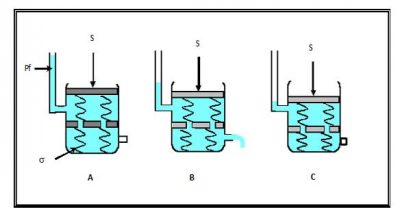
A: the lower tap is closed (no drainage) and S is only supported by the fluid:
S = Pf
B: The lower tap is open, water escapes and the spring/matrix bears part of the load: At that stage, if you close the tap, you get something similar to an undercompacted shale: the fluid is trapped in the sediment and supports part of the overburden, causing an overpressure.
S = Pf + ☌
C: The springs/matrix fully support the load: this is the case of a normally compacted sediment.
Pf = Ph
S = ☌
2. Aquathermal expansion
The volume of water increases with temperature, if it is in a sealed environment, its pressure increases. (Actual effect is controversial.)
3. Clay diagenesis
With depth, the smectites (as Montmorillonite) will lose its adsorbed water and transform into Illite with free water. (Not really a cause of overpressure, but acts as a contributory factor in case of under-compacted shale)
4. Osmosis
Osmosis is the spontaneous movement of water through a semi-permeable membrane separating two solutions of different concentrations, until the concentration of each solutions becomes equal.
A clay bed can act as a semi-permeable membrane between two reservoir containing water with different salinity. ( Note: Not proven in nature and anyway minor effect if exists.)
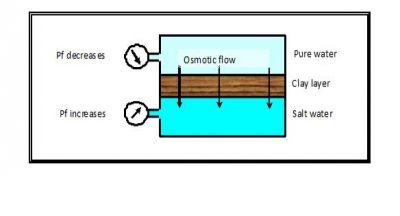
5. Evaporites
Sealing role: Evaporites are impermeable and can make a good seal that will block water expelled from underlying sediment, creating overpressure by overburden effect. (Note: Major role in overpressure generation, specially if interlayed with shale.)
6. Sulfate diagenesis
Gypsum is the precipitated form of CaSO4, transformation to Anhydrite may occur early in the burial process:
CaSO4,2H2O (Gypsum) D CaSO4 (Anhydrite) +2H2O
The water amounts to 38% of the original volume, if it cannot be expelled, overpressure develops. Similar increase of volume is created by rehydration of Anhydrite. Note: Minor effect as the diagenesis of gypsum to anhydrite often occurs at shallow depth, this allows the water to escape. Rehydration of Anhydrite is not proven on a scale that would be enough to generate overpressure.
7. Organic matter transformation
At shallow depth, bacteria will transform organic matter into biogenic methane. From a depth of 250m, thermochemical cracking will transform heavy hydrocarbons to lighter ones, with increase of volume. If these processes occur in a close environment, they create overpressure. Note: Important role in overpressure generation in confined series of shaly sands or carbonate.
Tectonics
8. Relief & structuring
Relief can be the cause of pressure anomalies (ie: artesian well). An artesian well is simply a well that doesn’t require a pump to bring water to the surface. This occurs when there is enough positive pressure in the aquifer to bring the water to the surface. An artesian aquifer is confined between impermeable rocks or clay which causes this positive pressure.
9. Re-organisation of stress field
Sediments are subjected to overburden and to horizontal tectonic stresses.
10. Faults
Faults can create a seal and stop the water or on the contrary, bring an overpressured zone in front of a permeable zone, allowing the water to escape
11. Carbonate compaction
Normally, carbonates do not have problems of undercompaction. Chalk is the exception. Chalk is due to the deposit of tiny discs called coccoliths (calcareous plates protecting some phytoplankton) and Chalk structure looks like Clay structure, with the same problem of low vertical permeability.
12. Permafrost
Typical of the artic zones. The overpressure is due to unfrozen pockets (called taliks) inside the permafrost. If a talik freeze, its volume tends to increase (remember that ice is bigger than original volume of water), but the permafrost impedes expansion, thus creating overpressure.
